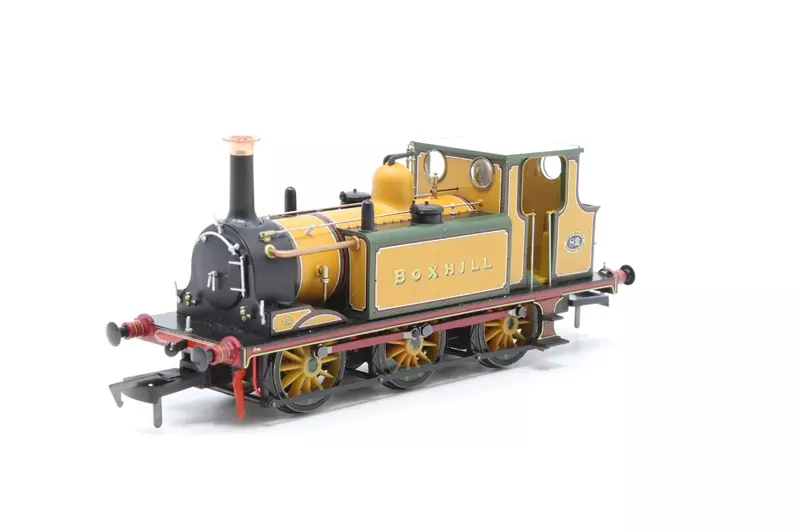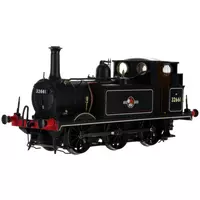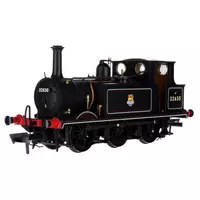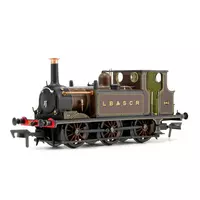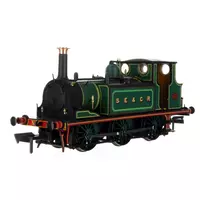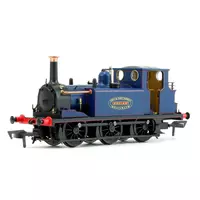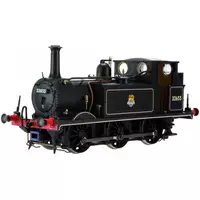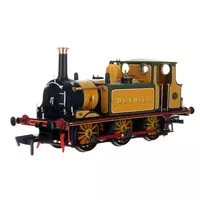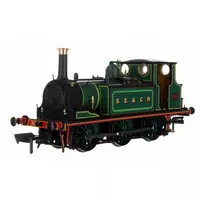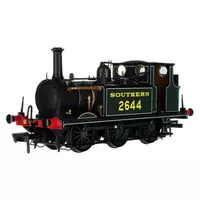Manufacturer catalogue image - please note that pre-release images may be CAD renders or CGI images rather than photographs
Prototype Eras
Era 2 (1875 to 1922) Pre-grouping
Era 5 (1957 to 1966) British Railways Late Crest
Manufacturer description
Model Details:
• DCC Ready – Next 18 Decoder Socket
• 00 Gauge
• LBSCR Improved Engine Green No.82 'Boxhill'
• This model has been developed and produced exclusively for Locomotionmodels by Dapol in a partnership with Rails of Sheffield
• 4S-010-NRM01
In 1872 the first of six A Class locomotive was built at Brighton. These proved ideal for hauling heavily loaded trains on commuter routes which were formed of featherweight stock over track which was at that time of lightweight construction. They soon received the nickname of ‘Terrier’ due to the sound of the exhaust or bark which sounded very similar to that from the breed of dog with the same name. Footplate staff called them ‘Rooters’ although the name ‘Terrier’ was better known.
They proved successful and a further 44 were built between 1874 and 1880. All were named after locations served by the company including several in East London served by the East London line and turned out in Stroudley’s elaborately lined ochre livery, known as “Improved Engine Green”. All were numbered in the series No. 35 to No. 84 inclusive. Built in 1878, No. 40 ‘Brighton’ was exhibited at the Paris Exhibition that year, where it was awarded a gold medal for workmanship. It put in a lively performance running over French tracks between Dieppe and Paris where it achieved an average speed of around 50 mph, out-performing the home locomotives which could not match it. The locomotive also worked on trains around Paris where it was used to demonstrate the Westinghouse air brake system.
No. 82 ‘Boxhill’ was built at Brighton in August 1880, a member of the last batch to be built. As such, she was fitted with iron brakes shoes; all earlier batches had been fitted with large wooden brakes shoes, which they retained for very many years. It is named after Box Hill the summit on the North Downs in Surrey and is the only member of the Class not to take its name from an area of London or a town/village.
At various times from 1900, Terriers were placed on the duplicate list, to release their numbers for new-build locomotives of other classes. The original numbers were pre-fixed by 6, with ‘Boxhill’ becoming No. 682.
By the 1890s with commuter trains becoming heavier and the routes over which they operated improved, the ‘Terriers’ required replacement and new tank locomotives were built to replace them. The future looked bleak for the class and in January 1899, the Locomotive Committee decided to reduce the class to just fifteen over the next three years. Following the sale, in 1898, of No. 72, Fenchurch, to the Newhaven Harbour Company, the LB&SCR realised that there was a market for second-hand Terriers. 23 surplus members of the Class were withdrawn by the LB&SCR between 1898 and 1905. Although some were scrapped, the majority were sold to other operators including the Newhaven Harbour Company (1), Edge Hill Light Railway (2), Isle of Wight Central (4), Freshwater, Yarmouth & Newport (1), Kent & East Sussex (2), London & South Western (2), Shropshire & Montgomeryshire (3), Weston, Clevedon & Portishead (2) and the South Eastern & Chatham Railway (1). Five locomotives were sold to Pauling & Co for use as contractors locomotives during the building of the Great Western & Great Central joint line which opened to traffic in 1905. Some were transferred to departmental stock for service for pilot duties at Brighton and Lancing Works. The Admiralty also purchased several for use in naval dockyards. The ‘Terriers’ found themselves transferred to branch line, shunting work or on pilot duties. They were ideal for use on lightly constructed lines.
The 1905-1906 withdrawal programme added a further fifteen Terriers to those still awaiting disposal. The completion of this programme would have seen the class decimated. Salvation came because the LB&SCR had a need to find means of operating short distance passenger services more economically, not least where the burgeoning electric tramway network was providing stiff competition. One of the more successful solutions was to introduce ‘push-pull’ “motor trains”. A tank locomotive was paired with one or more coaches and the use of a driving compartment at the end of the rear coach, linked to the locomotive cab to allow the driving to operate the locomotive from the coach, avoiding the need for the engine to run round its train.
ln 1905 No. 682 'Boxhill' was one of two locomotives experimentally converted to motor train working for trials on the Brighton – Worthing and Brighton - Kemp Town lines. It was thought to convert the pair to 2-4-0Ts, and, while 682 was not restored to an 0-6-0 until September 1912, no other class members were made 2-4-0Ts. In 1905 the Class were re-designated from A Class to A1 Class.
The motor-train trails were successful. Aside for a couple retained as works shunters, all the other surviving Terriers on the Brighton were converted to motor-train working between 1906 and 1912. 1905 had also seen the introduction of Marsh’s umber livery and, as the Terriers went through the Works, they lost their names and gained a coat of umber.
'Boxhill', worked as the Brighton Locomotive Works shunter from 1920, and in 1932 was renumbered as No. 380S. On being withdrawn by the Southern Railway in August 1946 it was earmarked for preservation and later passed into the National Collection and is currently on static display at the Railway Museum, York after being on display at the Museum of British Transport at Clapham, London for several years prior to its transfer to York.
Catalogue listing
Model details
Prototype information
Special commissions are usually only available new from the commissioning organisation, and may well have sold out on pre-order before they even end up listed here! But you may be able to find used items on marketplace or auction websites.
Supplier links are provided for your convenience and do not guarantee that the product is currently available. RailwayModels.uk is not a representative of these suppliers, but may receive a commission when purchases are made through links on this page.
